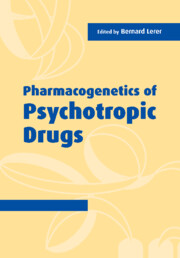Book contents
- Frontmatter
- Contents
- List of contributors
- Part I Introduction
- Part II Clinical background and research design
- Part III Molecular background
- Part IV Pharmacokinetics
- Part V Specific psychotropic drugs and disorders
- 10 Clozapine response and genetic variation in neurotransmitter receptor targets
- 11 Genetic factors underlying drug-induced tardive dyskinesia
- 12 Functional gene-linked polymorphic regions in pharmacogenetics
- 13 Alternative phenotypes and the pharmacogenetics of mood and anxiety disorders
- 14 Pharmacogenetics of anxiolytic drugs and the GABA–benzodiazepine receptor complex
- 15 Genetic factors and long-term prophylaxis in bipolar disorder
- 16 Genetic influences on responsiveness to anticonvulsant drugs
- 17 Apolipoprotein E as a marker in the treatment of Alzheimer's disease
- 18 Genetic variation and drug dependence risk factors
- Part VI Pharmacogenetics and brain imaging
- Part VII Industry perspectives
- Index
12 - Functional gene-linked polymorphic regions in pharmacogenetics
from Part V - Specific psychotropic drugs and disorders
Published online by Cambridge University Press: 20 August 2009
- Frontmatter
- Contents
- List of contributors
- Part I Introduction
- Part II Clinical background and research design
- Part III Molecular background
- Part IV Pharmacokinetics
- Part V Specific psychotropic drugs and disorders
- 10 Clozapine response and genetic variation in neurotransmitter receptor targets
- 11 Genetic factors underlying drug-induced tardive dyskinesia
- 12 Functional gene-linked polymorphic regions in pharmacogenetics
- 13 Alternative phenotypes and the pharmacogenetics of mood and anxiety disorders
- 14 Pharmacogenetics of anxiolytic drugs and the GABA–benzodiazepine receptor complex
- 15 Genetic factors and long-term prophylaxis in bipolar disorder
- 16 Genetic influences on responsiveness to anticonvulsant drugs
- 17 Apolipoprotein E as a marker in the treatment of Alzheimer's disease
- 18 Genetic variation and drug dependence risk factors
- Part VI Pharmacogenetics and brain imaging
- Part VII Industry perspectives
- Index
Summary
OVERVIEW
Starting from the complexity of neural pathways and their close integration, this chapter focuses on the possible advantages of investigating polymorphisms involved in the regulation of gene expression or in variation of enzymatic activity, using examples related to neurotransmitter pathway modulation (namely, uptake and metabolism). These examples (i.e., serotonin transporter-linked polymorphic region, monoamine oxidase A (MAO-A) promoter region, and catechol-O-methyltransferase (COMT)) are also used to support the hypothesis that quantitative variations of expression and functional levels would be better than structural changes at single receptor sites to identify differences in both treatment response and, likely, psychopathology. The possible influence of the serotonin (5-HT) transporter variants on the efficacy of fluvoxamine, paroxetine, pindolol augmentation, and on the effects of total sleep deprivation, is described in depression. The possible importance of this functional polymorphism in obsessive-compulsive disorder (OCD), stress reactivity and panic disorder (PD) is also discussed. Variations in MAO-A activity in female patients are discussed in relation to the pharmacogenetics of panic disorder, together with some hypotheses regarding the chromosomal location of the gene. Some preliminary results are described linking a functional polymorphism in the coding sequence of the gene COMT and antidepressant response in unipolar depression and bipolar mood disorder. Finally, the expected impact of new approaches (i.e., orphan receptor research, nucleic acid chips, and single nucleotide polymorphisms) is discussed in terms of the advantages and pitfalls (e.g., many new exciting data but also a stronger need for very careful replications and analysis).
Keywords
- Type
- Chapter
- Information
- Pharmacogenetics of Psychotropic Drugs , pp. 267 - 282Publisher: Cambridge University PressPrint publication year: 2002

